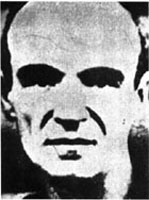Pavel Nikolaevich Filonov:
Biography
Born
Moscow, Jan.8, 1883; died Leningrad, Dec.3,1941
At the early age of
six, he was forced to go to work to help his poor family.
1897: moved
to St.Petersburg
In 1896 he was orphaned and moved in with his married
sister in St.Petersburg, where in 1897 he was sent to study painting.
1901-3: engaged in house painting, decorating, and restoration work
He engaged in a variety of jobs: from painting over roofs to washing sculptures
on roofs and paintng over a roial minister's residence. He worked standing, sitting,
lying down, having to face the risk of falling off the roof.
1903-8:
at the privat studio of th eacademician Lev Dmitriev-Kavkazsky
In 1903
the young Filonov failed his entry examination at the Academy of Arts. Then he
entered a privat art workshop headed by Lev Dmitriev-Kavkazsky, where he studied
anatomy, painted and drew from life to make it to the Academy.
1908-10:
attended thr St. Peterburg Academy of Arts
Having studied there for
two years, he voluntarily left since had not accepted the prevailing rules of
it and never followed them.
1910: close to the Union of Youth, contributing
to three of its exhibitions
He was a member of the "Union of Youth" group
and participated in their 1910, 1912 and 1913-14 exibitions in St. Petersburg,
and the Donkey's Tail in Moscow.
1912: traveled to Italy and France
The travelling conditions were not new to him. He had to walk for 36 day to make
it to Italy. While seeking employment, he walked from city to city and had to
sleep under bushes. He didn't have a chance to see the Sixt's Chapel since he
had no money.
1913: with Iosif Skolnik designed decor for Mayakovsky's
productiion of Vladimir Mayakovsky, a tragedy
1914-15: illustrated
Futurist booklets and published a neologistic poem with his own illustrations;
propounded the first ideas of his theory of analytical art and his system called
Universal Flowering
Filonov wrote the first edition of The
Ideology of Analytical Art and the Principle of Madeness. For the first time
the slogans of madeness and the negation of all existing opinions emerged.
1916-18: military service
From
1916 to 1918 served on the Rumanian front. In 1917 he actively participated in
the Bolshevik Revolution.
1919: at the Palace of the Arts there
was the First State Free Exhibition of Works of Art, in which Filonov was presented
with 22 pictures under the common title "Universal Flowering".
1923:
professor at the Petrograd Academy of Arts and the associate of the Petrograd
Institute of Artistic culture; wrote his second draft of his theory of analytical
art
Pavel Filonov briefly headed the General Ideology Department at the
Museum of Painterly Culture, which was established under Malevich's direction
in 1923. He remained in the position only a few months, and differed with all
of his colleagues on matters of artistic policy. Moreover, he is in almost all
respects impossible to place within a specific group. But at that point Filonov
started having students of his own, something which was not to change for the
rest of his life. He continued his thinking process and presented all og his new
ideas in the second edition of "Ideology of Analytical Art".
1925:
established the Collective of Masters of Analytical Art (Filonov School); the
groop held several exhibitions in the late 1920s and early 1930s
1929-30:
one-man show planned at the Russian Museum, Leningrad; the exhibition catalog
was printed in 1929 and issued in 1930, and although the preparations for the
exhibition reached their final stage, ultimately it did not open
For a
year and a half in closed doors the exposition in which all the artist's works
(more than 300 paintings and drawings) were presented was the subject of bitter
debates. However, eventually it was never opened.
1930s: continued
to paint according to his theories
In 1932, on the fifteenth anniversary
of the Bolshvik Revolution, 74 of Filonov's works were presented. This was to
be the last exhibition in which he was to take part. The last years of his life
his living conditions deteriorated as he did not sell his works deliberately.
As a result, he died of hunger in 1941 at the very beginning of the Nazi 's siege
of Leningrad.
The artist willed all his work "to the State, so that it
will form the basis of a museum of analytical art"
Filonov's main theoretical
work is The ideology of Analytical Art
Art of the Avant-Garde
in Russia: Selections from the George Costakis Collection, The Solomon R.
Guggenheim Museum, New York, 1981
Filonov's
Paintings at the Gallery •
People • History
© 1997-2012 Dina Belaia — All rights reserved